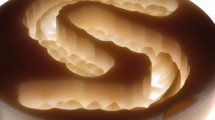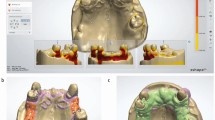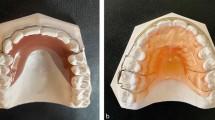Abstract
New materials are continuously being developed and advanced for the provision of partial dentures. However, the rate at which they are developing makes it hard for the clinician to discern which would be worth adopting into their practice.
This paper looks at some of those materials, including the earlier alternatives to conventional acrylic resins, polyamides and acetal resin, followed by a review of the newer novel polymers that are currently in use, including aryl-ketone-polymers and the polymer group polyaryletherketones.
The newer polymers have many similarities, in both properties and aesthetics, such as increased elasticity that allows the dentures to engage deeper undercuts, while maintaining high strength. A significant benefit of the novel polymers is in their ability to fit into a digital workflow. Computer-aided design and manufacture confer a high degree of consistency, efficiency and accuracy in the prosthesis. The ability to use precise digital tools to create frameworks and clasps of accurate parameters limits the introduction of technical error that has the potential to be introduced in the construction of a conventional cobalt-chrome framework.
The novel high-performance polymers show great promise. Research is needed on these materials investigating the effects on oral health, longevity and survival of the appliances, as well as studies looking at patient satisfaction and the impact on quality of life.
Key points
-
Many of the first generation of metal-free materials fell short of providing the mechanical properties required to allow the dentist and technician to provide a denture that conforms to conventional prosthodontic principles.
-
The novel high-performance polymers appear to address many of these shortfalls and merit consideration.
-
This paper provides a summary of the novel high-performance polymers to enable clinicians to make informed decisions regarding material choice.
This is a preview of subscription content, access via your institution
Access options
Subscribe to this journal
Receive 24 print issues and online access
$259.00 per year
only $10.79 per issue
Buy this article
- Purchase on Springer Link
- Instant access to full article PDF
Prices may be subject to local taxes which are calculated during checkout





Similar content being viewed by others
References
Beuer D, Schweiger J, Edelhoff D. Digital Dentistry: An Overview of Recent Developments for CAD/CAM Generated Restorations. Br Dent J 2008; 204: 505-511.
Steele J, O'Sullivan I. Executive Summary: Adult Dental Health Survey 2009. 2011. Available at http://qna.files.parliament.uk/qna-attachments/873000/original/adul-dent-heal-surv-summ-them-exec-2009-rep2.pdf (accessed May 2021).
Abt E, Carr A B, Worthington H V. Interventions for replacing missing teeth: partially absent dentition. Cochrane Database Syst Rev 2012; DOI: 10.1002/14651858.CD003814.pub2.
Bradnock G, White D, Nuttall N, Morris A, Treasure E, Pine C. Dental attitudes and behaviours in 1998 and implications for the future. Br Dent J 2001; 190: 228-232.
Ali Z, Baker S, Shahrbaf S, Martin N, Vettore M. Oral Health-Related Quality of Life After Prosthodontic Treatment for Patients With Partial Edentulism: A Systematic Review and Meta-Analysis. J Prosthet Dent 2019; 121: 59-68.
Preshaw P, Walls A, Jakubovicsm N, Moynihan P, Jepson N, Loewy Z. Association of removable partial denture use with oral and systemic health. J Dent 2011; 39: 711-719.
Budtz-Jørgensen E, Isidor F. Cantilever bridges or removable partial dentures in geriatric patients: a two-year study. J Oral Rehabil 1987; 14: 239-249.
Budtz-Jørgensen E, Isidor F. A 5-year longitudinal study of cantilevered fixed partial dentures compared with removable partial dentures in a geriatric population. J Prosthet Dent 1990; 64: 42-47.
Jepson N, Moynihan P, Kelly P, Watson G, Thomason J. Caries incidence following restoration of shortened lower dental arches in a randomized controlled trial. Br Dent J 2001; 191: 140-144.
Sheejith M, Swapna C, Roshy G, Niveditha S. Evolution of Denture Base Materials from Past to New Era. J Dent Med Sci 2018; 17: 23-27.
Carlsson G, Hedegård B, Koivumaa K. Studies in partial dental prosthesis. IV. Final results of a 4-year longitudinal investigation of dentogingivally supported partial dentures. Acta Odontol Scand 1965; 23: 443-472.
Fenner W, Gerber A, Mühlemann H. Tooth mobility changes during treatment with partial denture prosthesis. J Prosthet Dent 1956; 6: 520-525.
Campbell S, Cooper L, Craddock H et al. Removable partial dentures: The clinical need for innovation. J Prosthet Dent 2017; 118: 273-280.
Arnold C, Hey J, Schweyen R, Setz J. Accuracy of CAD-CAM-fabricated removable partial dentures. J Prosthet Dent 2018; 119: 586-592.
Alageel O, Abdallah M, Alsheghri A, Song J, Caron E, Tamimi F. Removable partial denture alloys processed by laser-sintering technique. J Biomed Mater Res B Appl Biomater 2018; 106: 1174-1185.
Marie A, Keeling A, Hyde T, Nattress B, Pavitt S, Murphy R. Deformation and retentive force following in vitro cyclic fatigue of cobalt-chrome and aryl ketone polymer (AKP) clasps. Dent Mater 2019; DOI: 10.1016/j.dental.2019.02.028.
Keltjens H, Mulder J, Käyser A, Creugers N. Fit of direct retainers in removable partial dentures after 8 years of use. J Oral Rehabil 1997; 24: 138-142.
Magnusson B, Bergman M, Bergman B, Söremark R. Nickel allergy and nickel-containing dental alloys. Scand J Dent Res 1982; 90: 163-167.
Thomas P, Bandl W, Maier S, Summer B, Przybilla B. Hypersensitivity to titanium osteosynthesis with impaired fracture healing, eczema, and T-cell hyperresponsiveness in vitro: case report and review of the literature. Contact Dermatitis 2006; 55: 199-202.
Matthews E, Smith D C. Nylon as a denture base material. Br Dent J 1955; 98: 231-237.
Sadek S, Dehis W, Hassan H. Comparative study clarifying the most suitable material to be used as partial denture clasps. Open Access Maced J Med Sci 2018; 6: 1111-1119.
Ardelean L, Bortun C, Motoc M. Metal-free removable partial dentures made of a thermoplastic acetal resin and two polyamide resins. Mater Plast 2007; 44: 345-348.
Vivek R. Polyamides As A Denture Base Material - A Review. J Dent Med Sci 2016; 15: 119-121.
Singh K, Aeran H, Kumar N, Gupta N. Flexible thermoplastic denture base materials for aesthetical removable partial denture framework. J Clin Diagn Res 2013; 7: 2372-2373.
Vojdani M, Giti R. Polyamide as a Denture Base Material: A Literature Review. J Dent (Shiraz) 2015; 16: 1-9.
Ucar Y, Akova T, Aysan I. Mechanical properties of polyamide versus different PMMA denture base materials. J Prosthodont 2012; 21: 173-176.
Zoidis P, Papathanasiou I, Polyzois G. The Use of a Modified Poly-Ether-Ether-Ketone (PEEK) as an Alternative Framework Material for Removable Dental Prostheses. A Clinical Report. J Prosthodont 2016; 25: 580-584.
Turner J, Radford D, Sherriff M. Flexural properties and surface finishing of acetal resin denture clasps. J Prosthodont 1999; 8: 188-195.
Lekha K, Roseline M, Savitha N, Nadiger R. Acetal resin as an esthetic clasp material. J Interdiscip Dent 2012; 2: 11-14.
Kurtz S. Chapter 1 - An Overview of PEEK Biomaterials. In Kurtz S (ed) PEEK Biomaterials Handbook. pp 1-7. Amsterdam: Elsevier, 2012.
Muhsin S, Hatton P, Johnson A, Sereno N, Wood D. Determination of Polyetheretherketone (PEEK) mechanical properties as a denture material. Saudi Dent J 2019; 31: 382-391.
Benakatti V, Sajjanar A, Acharya A. Polyetheretherketone (PEEK) in Dentistry. J Clin Diagn 2019; 13: 10-12.
Harb I, Abdel-Khalek E, Hegazy S. CAD/CAM Constructed Poly(etheretherketone) (PEEK) Framework of Kennedy Class I Removable Partial Denture: A Clinical Report. J Prosthodont 2019; DOI: 10.1111/jopr.12968.
Skirbutis G, Dzingute A, Masilunaite V. PEEK polymer's properties and its use in prosthodontics. A review. Stomatologija 2018; 20: 54-58.
Bathala L, Majeti V, Rachuri N. The Role of Polyether Ether Ketone (PEEK) in Dentistry-A Review. J Med Life 2019; 12: 5-9.
Ali Z, Baker S, Sereno N, Martin N. A Pilot Randomized Controlled Crossover Trial Comparing Early OHRQoL Outcomes of Cobalt-Chromium Versus PEEK Removable Partial Denture Frameworks. Int J Prosthodont 2020; 33: 386-392.
Najeeb S, Zafar M, Khurshid Z, Siddiqui F. Applications of polyetheretherketone (PEEK) in oral implantology and prosthodontics. J Prosthodont Res 2016; 60: 12-19.
Muhsin S, Wood D, Johnson A, Hatton P. Effects of Novel Polyetheretherketone (PEEK) Clasp Design on Retentive Force at Different Tooth Undercuts. J Oral Dent Res 2018; 5: 13-25.
Copponnex T. Like a chameleon. Medical Device Developments. 2010. Available online at http://www.cmdental.fr/medias/files/publications-pekkton-2014.pdf (accessed August 2020).
Dawson H, Hyde B, Hurst M, Harris B, Lin W. Polytherketoneketone (PEKK), a framework material for complete fixed and removable dental prostheses: A clinical report. J Prosthet Dent 2018; 119: 867-872.
Fuhrmann G, Steiner M, Freitag-Wolf S, Kern M. Resin bonding to three types of polyaryletherketones (PAEKs)-Durability and influence of surface conditioning. Dent Mater 2014; 30: 357-363.
Copponnex T, Blumli M. New material approaches in dental technology. meditec. 2011. Available online at http://www.cmdental.fr/medias/files/publications-pekkton-2014.pdf (accessed August 2020).
Han K H, Lee J Y, Shin S. Implant-And Tooth-Supported Fixed Prostheses Using a High-Performance Polymer (Pekkton) Framework. Int J Prosthodont 2016; 29: 451-454.
Nattress B, Touloumi F, Thalji G et al. OHRQoL Comparison Between Cobalt Chrome Versus Polymer Removable Partial Dentures. 2020. Available online at https://iadr.abstractarchives.com/abstract/20iags-3316559/ohrqol-comparison-between-cobalt-chrome-versus-polymer-removable-partial-dentures (accessed May 2021).
Williams G, Thomas M, Addy L. Precision Attachments in Partial Removable Prosthodontics: An Update for the Practitioner Part 1. Dent Update 2014; 41: 725-731.
Fueki K, Ohkubo C, Yatabe M et al. Clinical application of removable partial dentures using thermoplastic resin-part I: definition and indication of non-metal clasp dentures. J Prosthodont Res 2014; 58: 3-10.
Zlatarić D, Celebić A, Valentić-Peruzović M. The effect of removable partial dentures on periodontal health of abutment and non-abutment teeth. J Periodontol 2002; 73: 137-144.
Davenport J, Basker R, Heath J, Ralph J, Glantz P O, Hammond P. A Clinical Guide to Removable Partial Denture Design. 1st ed. London: BDJ Books, 2000.
Owall B, Budtz-Jörgensen E, Davenport J et al. Removable partial denture design: a need to focus on hygienic principles? Int J Prosthodont 2002; 15: 371-378.
Petridis H, Tj H. Periodontal considerations in removable partial denture treatment: a review of the literature. Int J Prosthodont 2001; 14: 164-172.
Solvay Dental 360. Biofilm Study Review: In vitro Biofilm Formation Studies on Polymer Coupons. 2020. Available online at https://www.solvaydental360.com (accessed September 2020).
Tannous F, Steiner M, Shahin R, Kern M. Retentive forces and fatigue resistance of thermoplastic resin clasps. Dent Mater 2012; 28: 273-278.
Author information
Authors and Affiliations
Corresponding author
Ethics declarations
The authors declare no conflicts of interest.
Rights and permissions
About this article
Cite this article
Gray, D., Barraclough, O., Ali, Z. et al. Modern partial dentures - part 2: a review of novel metal-free materials and innovations in polymers. Br Dent J 230, 813–818 (2021). https://doi.org/10.1038/s41415-021-3068-y
Received:
Accepted:
Published:
Issue Date:
DOI: https://doi.org/10.1038/s41415-021-3068-y
This article is cited by
-
Modern partial dentures - part 1: novel manufacturing techniques
British Dental Journal (2021)



